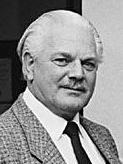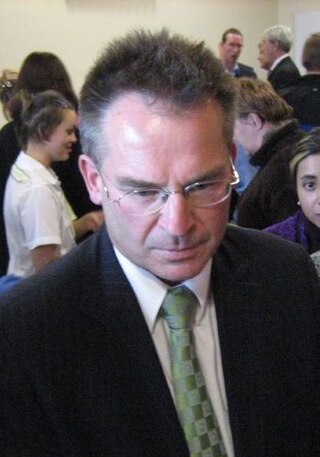
Rosemary Follett is an Australian former politician who was the first Chief Minister of Australian Capital Territory, serving in 1989 and again between 1991 and 1995. She was the first woman to become head of government in an Australian state or territory.
Residents Rally was an Australian political party, with four candidates elected to the first Australian Capital Territory Legislative Assembly at the 1989 Australian Capital Territory general election. The party was led by human rights barrister and lawyer, Bernard Collaery. Collaery defined the party as "a community-based urban green party". The Rally formed a coalition with the Liberal Party, led by Trevor Kaine, in late 1989. However, this fractious Alliance was to last for only two years before collapsing. The Rally was unsuccessful in retaining any seats at the 1992 ACT general election.
The Independents Group was a short-lived Australian political party operating in the Australian Capital Territory. They briefly served as part of the Alliance government, alongside the Liberal Party and Residents Rally.

Trevor Thomas Kaine, was an Australian politician who served as Chief Minister of the Australian Capital Territory from 1989 to 1991. Kaine was elected into a multi-member single electorate in the unicameral Australian Capital Territory Legislative Assembly, from 1989 to 2001, initially as a member of the Liberal Party and later as an independent.

The 1989 Australian Capital Territory general election was held on 4 March 1989 to elect the 1st Australian Capital Territory Legislative Assembly. This was the first direct election by voters in the Australian Capital Territory (ACT) for their power legislative body.

Elections to the Australian Capital Territory Legislative Assembly were held on Saturday, 18 February 1995. The incumbent Labor Party, led by Rosemary Follett, was challenged by the Liberal Party, led by Kate Carnell. For the first time, candidates were elected to fill three multi-member electorates using a single transferable vote method, known as the Hare-Clark system. The result was another hung parliament. However the Liberals, with the largest representation in the 17-member unicameral Assembly, formed Government with the support of Michael Moore and Paul Osborne. Carnell was elected Chief Minister at the first sitting of the third Assembly on 9 March 1995.

Elections to the Australian Capital Territory Legislative Assembly were held on Saturday, 18 October 2008. The incumbent Labor Party, led by Jon Stanhope, was challenged by the Liberal Party, led by Zed Seselja. Candidates were elected to fill three multi-member electorates using a single transferable vote method, known as the Hare-Clark system. The result was another hung parliament with Labor winning seven seats, the Liberals six seats and the Greens finishing with four seats, giving the Greens the balance of power in the 17-member unicameral Assembly. On 31 October 2008, after almost two weeks of deliberations, the Greens chose to support a Labor minority government. Consequently, Labor was re-elected to a third consecutive term of government in the ACT. Stanhope was elected Chief Minister at the first sitting of the seventh Assembly on 5 November 2008. The election was conducted by the ACT Electoral Commission.
The Australian Capital Territory House of Assembly was the main elected representative body of the Australian Capital Territory between 1975 and 1986, during which time preparation began for the granting of self-government to the Territory. The Assembly had a largely advisory role, with most of the power over the Territory being in the hands of the relevant federal minister.
Robyn Margaret Nolan is an Australian politician and was a member of the first multi-member single electorate Australian Capital Territory Legislative Assembly representing, initially, the Liberal Party. Nolan was elected at the 1989 general election and then resigned from the Liberal Party on 11 October 1991, sat briefly as an independent, before founding the New Conservative Group on 19 November 1991. Nolan sought re-election, leading the New Conservative party ticket, at the 1992 general election, however was unsuccessful in retaining her seat.
Paul Russell Whalan is an Australian political lobbyist and former politician who was a member of the first Australian Capital Territory Legislative Assembly. He served as the leader of the ACT Labor Party in the mid-1980s and was the leader of the party's Right faction.

The Deputy Chief Minister of the Australian Capital Territory is the second-most senior officer in the government of the Australian Capital Territory. The position has been a ministerial portfolio since its establishment in 1989. Unlike in other states and territories, the deputy chief minister of the ACT is not nominally appointed by an administrator or vice-regal, but by the chief minister.

Elections to the Australian Capital Territory Legislative Assembly occurred on Saturday, 20 October 2012. The 11-year incumbent Labor Party, led by Chief Minister Katy Gallagher, won a fourth term over the main opposition Liberal Party, led by opposition leader Zed Seselja.
The ACT Labor Party, officially known as the Australian Labor Party (ACT Branch) and commonly referred to simply as ACT Labor, is the Australian Capital Territory branch of the Australian Labor Party (ALP). The branch is the current ruling party in the ACT and is led by Andrew Barr, who has concurrently served as chief minister since 2014. It is one of two major parties in the unicameral ACT Legislative Assembly, and is currently in a coalition with the ACT Greens.
The 1992 Australian Capital Territory electoral system referendum was a referendum held on 15 February 1992, asking voters in the Australian Capital Territory (ACT) to choose their electoral system. The referendum took place alongside the 1992 ACT election.

The 2020 Australian Capital Territory general election was held on 17 October 2020 to elect all 25 members of the unicameral ACT Legislative Assembly.

The 2024 Australian Capital Territory general election was held on 19 October 2024 to elect all 25 members of the unicameral ACT Legislative Assembly.
The Canberra Liberals, the division of the Liberal Party of Australia in the Australian Capital Territory (ACT), have held a number of leadership elections and deputy leadership elections. The most recent was held in October 2020, and another will be held in 2024.
James "Jim" W. Leedman is an Australian former politician who served as leader and president of the Liberal Party in the Australian Capital Territory (ACT).
The ACT Labor Party, the division of the Australian Labor Party in the Australian Capital Territory (ACT), have held a number of leadership elections and deputy leadership elections. The most recent was held in November 2020, although the most recent leadership change was in December 2014.

The Alliance, sometimes known as the Liberal–Residents Rally Alliance, was a political alliance between the Liberal Party, Residents Rally and Independents Group in the Australian Capital Territory Legislative Assembly.












